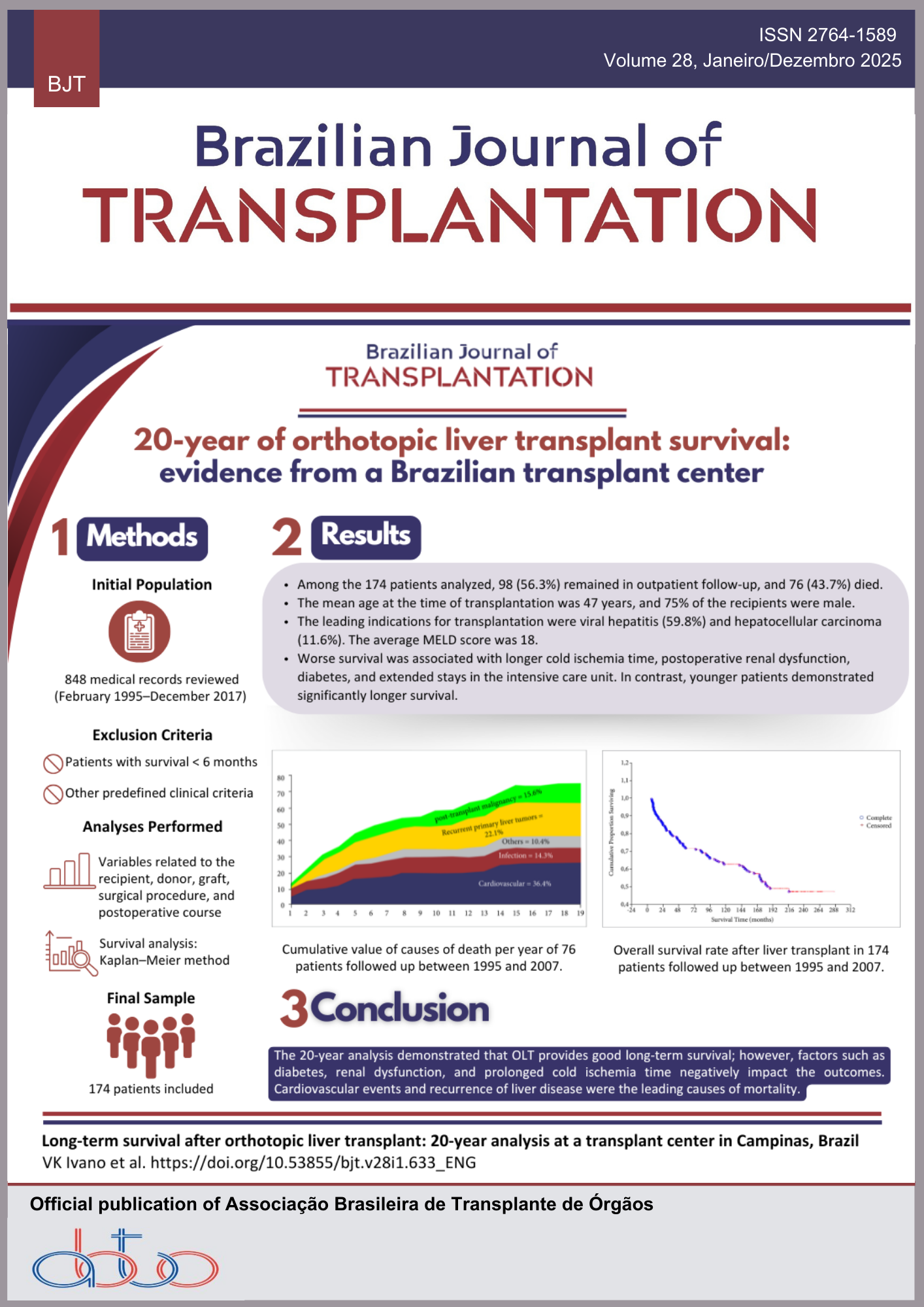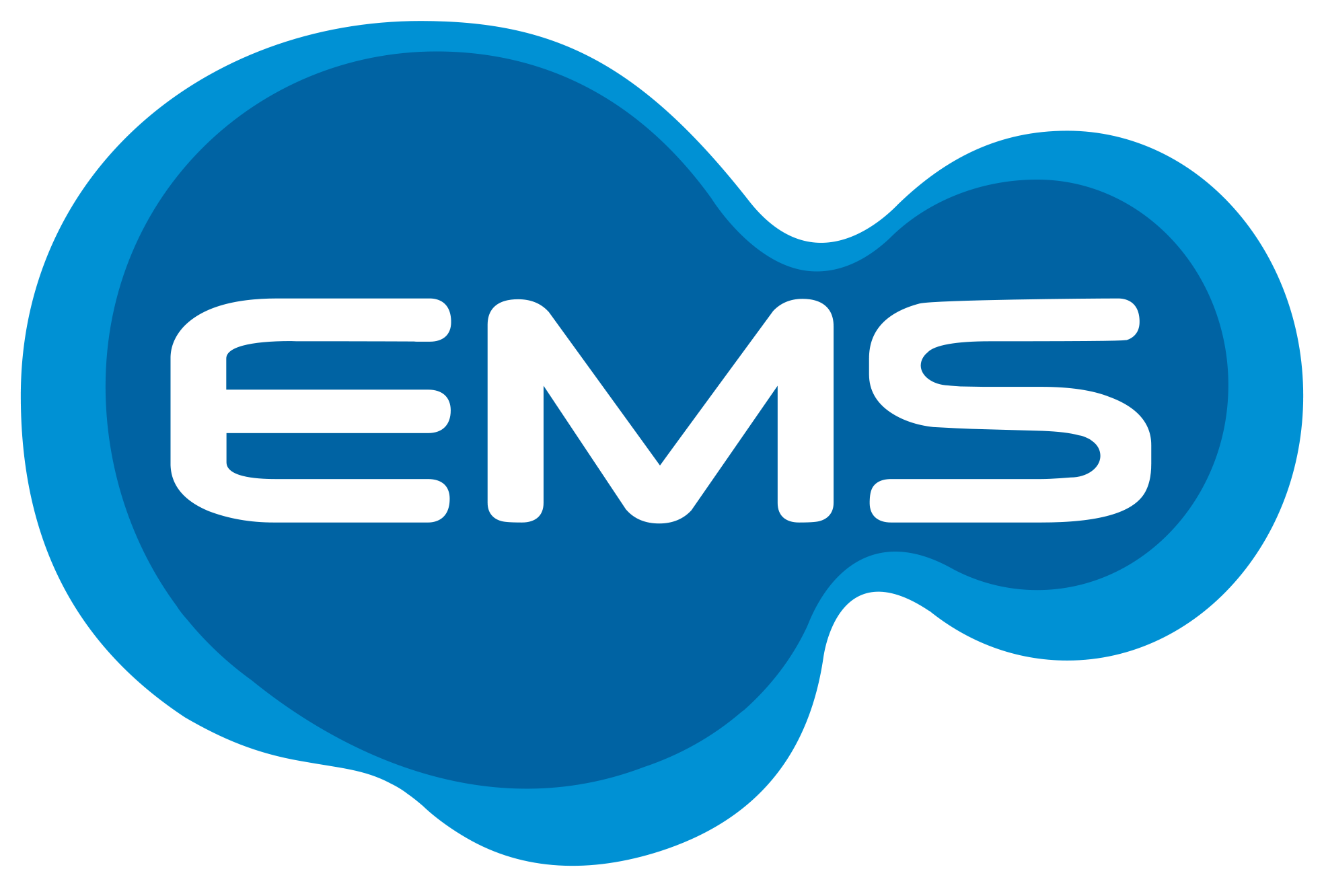El papel de la Orina-1 y la microscopía urinaria en el diagnóstico de lesión renal aguda.
Palabras clave:
lesión renal aguda, trasplante de hígado, biomarcadoresResumen
Introducción: La lesión renal aguda (LRA) es una complicación frecuente en la unidad de cuidados intensivos. La orina-1 (U-1) es una herramienta que a menudo se pasa por alto para evaluar la LRA y no existe un consenso basado en la evidencia sobre el uso de la orina-1. El objetivo del estudio fue investigar el papel de la U-1 y la microscopía urinaria (MU) en el diagnóstico de IRA grave y la necesidad de terapia de reemplazo renal (TRR) en pacientes sometidos a trasplante hepático (TH).
Método: Nuestra hipótesis fue determinar si los parámetros urinarios disponibles U-1 y MU están asociados con el diagnóstico de IRA grave y la necesidad de TRR. Evaluamos U-1 y MU a las 6 horas después del TH. El criterio utilizado para el diagnóstico de IRA fue el KDIGO basado solo en la creatinina sérica en una semana.
Resultados: Ochenta y siete pacientes desarrollaron IRA en la primera semana después del TH. El diagnóstico de IRA grave (KDIGO 2 y 3) se encontró en 59 pacientes. A las seis horas del LT, las variables en U-1 fueron predictoras de IRA grave, con AUC 0,65- proteínas, 0,68- leucocitos y 0,63- eritrocitos. En la determinación de TSR, estas variables se comportaron mejor con AUC: 0,72- proteínas, 0,69- leucocitos y 0,68- eritrocitos. Los grupos no IRA y IRA tienen una distribución similar de la microscopía urinaria.
Conclusión: Parámetros simples y habituales en la práctica clínica, como proteinuria, eritrocitos y leucocituria, pueden ser herramientas valiosas para el diagnóstico de IRA grave y la necesidad de TRR.
Descargas
Citas
Hoste EA, Bagshaw SM, Bellomo R, Cely CM, Colman R, Cruz DN. Epidemiology of acute kidney injury in critically ill patients: the multinational AKI-EPI study. Intensive Care Med. 2015;41:1411-23. https://doi.org/10.1007/s00134-015-3934-7
Bellomo R, Kellum J, Ronco C. Acute renal failure: time for consensus. Intensive Care Med. 2001; 27: 1685-8. https://doi. org/10.1007/s00134-001-1120-6
Clermont G, Acker CG, Angus DC, Sirio CA, Pinsky MR, Johnson JP. Renal failure in ICU: comparison of the impact of acute renal failure and end-stage renal disease on ICU outcomes. Kidney Int. 2002; 62: 986-96. https://doi.org/10.1046/ j.1523-1755.2002.00509.x
Xue JL, Daniels F, Star RA, Kimmel PL, Eggers PW, Molitoris BA, et al. Incidence and mortality of acute renal failure in Medicare beneficiaries, 1992 to 2001. J Am Soc Nephrol. 2006; 17: 1135-42. https://doi.org/10.1681/ASN.2005060668
Mehta RL, Pascual MT, Soroko S, Savage BR, Himmelfarb J, Ikizler TA, et al. Spectrum of acute renal failure in the intensive care unit: the PICARD experience. Kidney Int. 2004; 66: 1613-21. https://doi.org/10.1111/j.1523-1755.2004.00927.x
Kellum JA, Prowle JR. Paradigms of acute kidney injury in the intensive care setting. Nat Rev Nephrol. 2018; 14(4): 217-30. https://doi.org/10.1038/nrneph.2017.184
Barri YM, Sanchez EQ, Jennings LW, Melton LB, Hays S, Levy MF, et al. Acute kidney injury following liver transplantation: definition and outcome. Liver Transpl. 2009; 15(5): 475-83. https://doi.org/10.1002/lt.21682
Kidney Disease: Improving Global Outcomes (KDIGO), Acute Kidney Injury Work Group. KDIGO clinical practice guideline for acute kidney injury. Kidney Int. 2012; Suppl. 2: 1-138.
Echeverry G, Hortin GL, Rai AJ. Introduction to urinalysis: historical perspectives and clinical application. Methods Mol Biol. 2010; 641: 1-12. https://doi.org/10.1007/978-1-60761-711-2_1
Wang L, Li X, Chen H, Yan S, Li D, Li Y, Gong Z. Coronavirus disease 19 infection does not result in acute kidney injury: an analysis of 116 hospitalized patients from Wuhan, China. Am J Nephrol. 2020; 51(5): 343-8. https://doi.org/10.1159/000507471
Cheng Y, Luo R, Wang K, Zhang M, Wang Z, Dong L. Kidney disease is associated with in-hospital death of patients with COVID-19. Kidney Int. 2020; 97(5) 829-38. https://doi.org/10.1016/j.kint.2020.03.005
Li Z, Wu M, Yao J, Guo J, Liao X, Song S. Caution on kidney dysfunctions of 2019-nCoV patients. medRxiv. 2020. https:// doi.org/10.1101/2020.02.08.20021212
Cao M, Zhang D, Wang Y. Clinical features of patients infected with the 2019 novel coronavirus (COVID-19) in Shanghai, China. medRxiv. 2020. https://doi.org/10.1101/2020.03.04.20030395
Brasil. Ministério da Saúde. Portaria no 2.600, de 21 de outubro de 2009. Brasília (DF): Ministério da Saúde; 2009. [acesso em 10 ago 2024] Disponível em: https://bvsms.saude.gov.br/bvs/saudelegis/gm/2009/prt2600_21_10_2009.html
Perazella MA, Coca SG, Kanbay M, Brewster UC, Parikh CR. Diagnostic value of urine microscopy for differential diagnosis of acute kidney injury in hospitalized patients. Clin J Am Soc Nephrol. 2008; 3(6): 1615-9. https://doi.org/10.2215/ CJN.02860608
Linde JM, Nijman RJM, Trzpis M, Broens PMA. Prevalence of urinary incontinence and other lower urinary tract symptoms in children in the Netherlands. J Pediatr Urol. 2019;15(2): 164. e1-7. https://doi.org/10.1016/j.jpurol.2018.10.027
Kissling S, Rotman S, Gerber C, Halfon M, Lamoth F, Comte D. Collapsing glomerulopathy in a COVID-19 patient. Kidney Int. 2020; 98(1): 228-31. https://doi.org/10.1016/j.kint.2020.04.006
Larsen CP, Bourne TD, Wilson JD. Collapsing glomerulopathy in a patient with COVID-19. Kidney Int Rep. 2020; 5(6): 935- 9. https://doi.org/10.1016/j.ekir.2020.04.002
Nasr SH, Kopp JB. COVID-19-associated collapsing glomerulopathy: an emerging entity. Kidney Int Rep. 2020; 5(6): 759-61. https://doi.org/10.1016/j.ekir.2020.04.030
Martínez-Rojas MA, Vega-Vega O, Bobadilla NA. Is the kidney a target of SARS-CoV-2? Am J Physiol Renal Physiol. 2020; 318(6). https://doi.org/10.1152/ajprenal.00160.2020
Moreno JA, Martín-Cleary C, Gutiérrez E, Toldos O, Blanco-Colio LM, Praga M, et al. AKI associated with macroscopic glomerular hematuria: clinical and pathophysiologic consequences. Clin J Am Soc Nephrol. 2012; 7(1): 175-84. https://doi. org/10.2215/CJN.01970211
Moreno JA, Sevillano Á, Gutiérrez E, Guerrero-Hue M, Vázquez-Carballo C, Yuste C, et al. Glomerular hematuria: cause or consequence of renal inflammation? Int J Mol Sci. 2019; 20(9): 2205. https://doi.org/10.3390/ijms20092205
Gala-Błądzińska A, Żyłka A, Dumnicka P, Kuśnierz-Cabala B, Kaziuk MB, Kuźniewski M. Sterile leukocyturia affects urine neutrophil gelatinase-associated lipocalin concentration in type 2 diabetic patients. Arch Med Sci. 2017; 13(2): 321-7. https:// doi.org/10.5114/aoms.2016.64043
Karras A. Acute interstitial nephritis. Rev Prat. 2018; 68(2): 170-4.
D’Amico G, Bazzi C. Urinary protein and enzyme excretion as markers of tubular damage. Curr Opin Nephrol Hypertens. 2003 ;12: 639-43.
Pavenstädt H, Kriz W, Kretzler M. Cell biology of the glomerular podocyte. Physiol Rev. 2003; 83: 253-307. https://doi. org/10.1152/physrev.00020.2002
Klahr S, Miller SB. Acute oliguria. N Engl J Med. 1998; 338(10): 671-5. https://doi.org/10.1056/NEJM199803053381007
Esson ML, Schrier RW. Diagnosis and treatment of acute tubular necrosis. Ann Intern Med. 2002; 137(9):744-52. https://doi.org/10.7326/0003-4819-137-9-200211050-00010
Singri N, Ahya SN, Levin ML. Acute renal failure. JAMA. 2003; 289(6): 747-51. https://doi.org/10.1001/jama.289.6.747
Needham E. Management of acute renal failure. Am Fam Physician. 2005; 72(9): 1739-46.
Lameire N, Vanbiesen W, Vanholder R. Acute renal failure. The Lancet. 2005; 365(9457): 417-30. https://doi.org/10.1016/ S0140-6736(05)70238-5
Bagshaw SM, Haase M, Haase-Fielitz A, Bennett M, Devarajan P, Bellomo R. A prospective evaluation of urine microscopy in septic and non-septic acute kidney injury. Nephrol Dial Transplant. 2012; 27(2): 582-8. https://doi.org/10.1093/ndt/gfr331.
Barreto AG, Daher EF, Silva Junior GB, Garcia JH, Magalhães CB, Lima JM. Risk factors for acute kidney injury and 30-day mortality after liver transplantation. Ann Hepatol. 2015; 14: 688-94.
Baron-Stefaniak J, Schiefer J, Miller EJ, Berlakovich GA, BaronDM, Faybik P. Comparison of macrophage migration inhibitory factor and neutrophil gelatinaseassociated lipocalin-2 to predict acute kidney injury after liver transplantation: an observational pilot study. PLoS One. 2017; 12(8): 1-14. https://doi.org/10.1371/journal.pone.0183162
Descargas
Publicado
Cómo citar
Número
Sección
Licencia
Derechos de autor 2025 Camila Lima, Maria de Fatima Correa , Etienne Macedo

Esta obra está bajo una licencia internacional Creative Commons Atribución 4.0.










